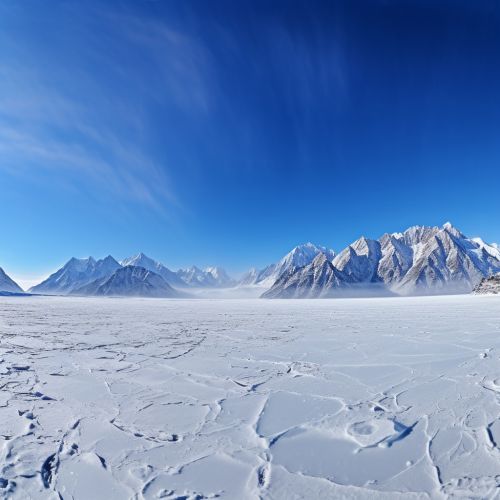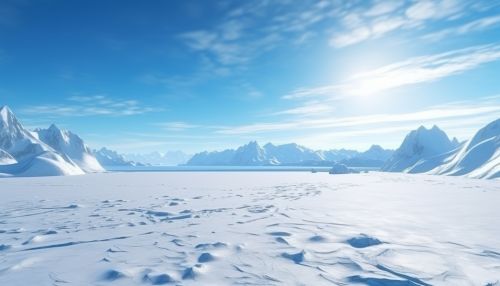Cryosphere
Overview
The Cryosphere refers to the frozen water part of the Earth system. Be it the polar ice caps, glaciers, permafrost, snow or sea ice, these frozen reservoirs of water make up a significant part of our planet. The term cryosphere is derived from the Greek word 'kryos', which means cold or ice, and 'sphere', in reference to the Earth. The cryosphere is an integral part of the Earth's climate system, interacting with the atmosphere, hydrosphere, and biosphere.


Components of the Cryosphere
The cryosphere encompasses several components, each with its unique characteristics and role in the Earth's climate system.
Sea Ice
Sea ice is frozen ocean water. It forms, grows, and melts in the ocean. In contrast, icebergs, glaciers, and ice shelves float in the ocean but originate on land. Sea ice plays a crucial role in regulating the Earth's climate by reflecting sunlight back into space and providing a habitat for polar species.
Snow
Snow is precipitation in the form of ice crystals. It originates from the freezing of the water vapor in the atmosphere. Snow cover acts as an insulator, reducing the rate of heat loss from the ground to the atmosphere, thus influencing the Earth's energy balance.
Glaciers
Glaciers are large, slow-moving masses of ice that form on land from the accumulation and compaction of snow over time. They are found in mountain ranges and polar regions worldwide, storing about 69% of the world's freshwater.
Ice Sheets
Ice sheets are massive expanses of ice covering more than 50,000 square kilometers. The two major ice sheets on Earth today cover most of Greenland and Antarctica.
Ice Caps and Ice Fields
Ice caps are miniature ice sheets, covering less than 50,000 square kilometers. They form primarily in polar and subpolar regions that are relatively flat and high in elevation. Ice fields are similar to ice caps but are interrupted by peaks of the underlying mountain ranges.
Permafrost
Permafrost is any ground that remains completely frozen—32°F (0°C) or colder—for at least two years straight. These permanently frozen grounds are most common in regions with high mountains and in Earth's higher latitudes—near the North and South Poles.
Role of the Cryosphere in the Climate System
The cryosphere plays a significant role in the Earth's climate system. It influences sea levels, the salinity of the oceans, and the amount of sunlight absorbed by the planet.
Albedo Effect
The cryosphere contributes to the Earth's albedo—the amount of sunlight reflected back into space. Snow and ice have high albedo and can reflect up to 90% of incoming sunlight, helping to cool the Earth.
Sea Level Regulation
The cryosphere plays a crucial role in regulating sea levels. When the cryosphere is in equilibrium, the amount of snow and ice accumulating is roughly equal to the amount melting or evaporating. When this balance is disrupted, as is happening with global warming, it can lead to rising sea levels.
Ocean Salinity
The cryosphere also influences the salinity of the oceans. Melting sea ice introduces freshwater into the ocean, which can disrupt ocean currents, which are driven in part by differences in water temperature and salinity.
Cryosphere and Climate Change
The cryosphere is one of the Earth's systems most sensitive to changes in temperature. With global temperatures on the rise, the cryosphere is undergoing significant changes, which have far-reaching implications for global climate patterns, ecosystems, and human societies.
Melting Glaciers and Ice Sheets
One of the most visible impacts of climate change on the cryosphere is the melting of glaciers and ice sheets. This melting contributes to rising sea levels, threatening coastal communities around the world.
Decreasing Sea Ice
The extent and thickness of sea ice in the Arctic have been decreasing over the past few decades. This loss of sea ice can exacerbate global warming by decreasing the Earth's albedo, leading to more heat being absorbed by the oceans.
Thawing Permafrost
Rising temperatures are causing permafrost to thaw, releasing the stored carbon in the form of carbon dioxide and methane, potent greenhouse gases. This release of greenhouse gases can further amplify global warming, leading to a feedback loop.
